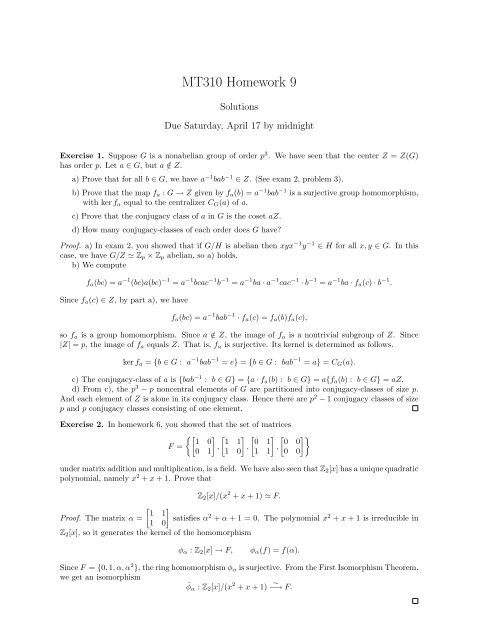Homework 9 solutions
Homework 9 solutions
Homework 9 solutions
You also want an ePaper? Increase the reach of your titles
YUMPU automatically turns print PDFs into web optimized ePapers that Google loves.
MT310 <strong>Homework</strong> 9<br />
Solutions<br />
Due Saturday, April 17 by midnight<br />
Exercise 1. Suppose G is a nonabelian group of order p 3 . We have seen that the center Z = Z(G)<br />
has order p. Let a ∈ G, but a /∈ Z.<br />
a) Prove that for all b ∈ G, we have a −1 bab −1 ∈ Z. (See exam 2, problem 3).<br />
b) Prove that the map fa : G → Z given by fa(b) = a −1 bab −1 is a surjective group homomorphism,<br />
with ker fa equal to the centralizer CG(a) of a.<br />
c) Prove that the conjugacy class of a in G is the coset aZ.<br />
d) How many conjugacy-classes of each order does G have?<br />
Proof. a) In exam 2, you showed that if G/H is abelian then xyx −1 y −1 ∈ H for all x, y ∈ G. In this<br />
case, we have G/Z Zp × Zp abelian, so a) holds.<br />
b) We compute<br />
fa(bc) = a −1 (bc)a(bc) −1 = a −1 bcac −1 b −1 = a −1 ba · a −1 cac −1 · b −1 = a −1 ba · fa(c) · b −1 .<br />
Since fa(c) ∈ Z, by part a), we have<br />
fa(bc) = a −1 bab −1 · fa(c) = fa(b)fa(c),<br />
so fa is a group homomorphism. Since a /∈ Z, the image of fa is a nontrivial subgroup of Z. Since<br />
|Z| = p, the image of fa equals Z. That is, fa is surjective. Its kernel is determined as follows.<br />
ker fa = {b ∈ G : a −1 bab −1 = e} = {b ∈ G : bab −1 = a} = CG(a).<br />
c) The conjugacy-class of a is {bab −1 : b ∈ G} = {a · fa(b) : b ∈ G} = a{fa(b) : b ∈ G} = aZ.<br />
d) From c), the p 3 − p noncentral elements of G are partitioned into conjugacy-classes of size p.<br />
And each element of Z is alone in its conjugacy class. Hence there are p 2 − 1 conjugacy classes of size<br />
p and p conjugacy classes consisting of one element.<br />
Exercise 2. In homework 6, you showed that the set of matrices<br />
<br />
1<br />
F =<br />
0<br />
<br />
0 1<br />
,<br />
1 1<br />
<br />
1 0<br />
,<br />
0 1<br />
<br />
1 0<br />
,<br />
1 0<br />
<br />
0<br />
0<br />
under matrix addition and multiplication, is a field. We have also seen that Z2[x] has a unique quadratic<br />
polynomial, namely x 2 + x + 1. Prove that<br />
Z2[x]/(x 2 + x + 1) F.<br />
<br />
1 1<br />
Proof. The matrix α =<br />
1 0<br />
Z2[x], so it generates the kernel of the homomorphism<br />
satisfies α 2 + α + 1 = 0. The polynomial x 2 + x + 1 is irreducible in<br />
φα : Z2[x] → F, φα(f) = f(α).<br />
Since F = {0, 1, α, α2 }, the ring homomorphism φα is surjective. From the First Isomorphism Theorem,<br />
we get an isomorphism<br />
¯φα : Z2[x]/(x 2 + x + 1) ∼<br />
−→ F.
Exercise 3. Let F be a field, and let f(x) ∈ F [x] be a polynomial of degree n ≥ 1, generating the<br />
ideal (f) = {gf : g ∈ F [x]}. Prove that each coset in F [x]/(f) contains a unique polynomial of degree<br />
< n.<br />
Proof. The ideal (f) is unchanged if we divide f by its coefficient of x n . Hence we may assume that f<br />
is monic:<br />
f(x) = x n + an−1x n−1 + · · · + a1x + a0.<br />
It suffices to prove by induction on k ≥ 0 that<br />
x n+k ∈ hk(x) + (f),<br />
where hk(x) ∈ F [x] has degree < n. For k = 0, we have<br />
x n = −an−1x n−1 − · · · − a1x − a0 + f(x),<br />
so the claim holds, with h0(x) = −an−1x n−1 − · · · − a1x − a0. Assume that x n+k−1 ∈ hk−1(x) + (f),<br />
where hk−1(x) ∈ F [x] has degree < n. Write<br />
where deg ℓ(x) < n − 1. Then<br />
hk−1(x) = cn−1x n−1 + ℓ(x),<br />
x n+k ∈ xhk−1(x) + (f) = cn−1x n + xℓ(x) + (f) = cn−1h0(x) + xℓ(x) + (f).<br />
Thus, we have x n+k ∈ hk(x) + (f), where hk(x) = cn−1h0(x) + xℓ(x). Since h0(x) and xℓ(x) both have<br />
degree < n, it follows that deg hk < n, so the claim is proved by induction.<br />
As for uniqueness, suppose g+(f) = h+(f) with both g and h having degrees < n. Then g−h ∈ (f),<br />
so f divides the polynomial g − h of degree < n. Since deg f = n, this can only hold if g − h = 0, that<br />
is, if g = h.<br />
2

















